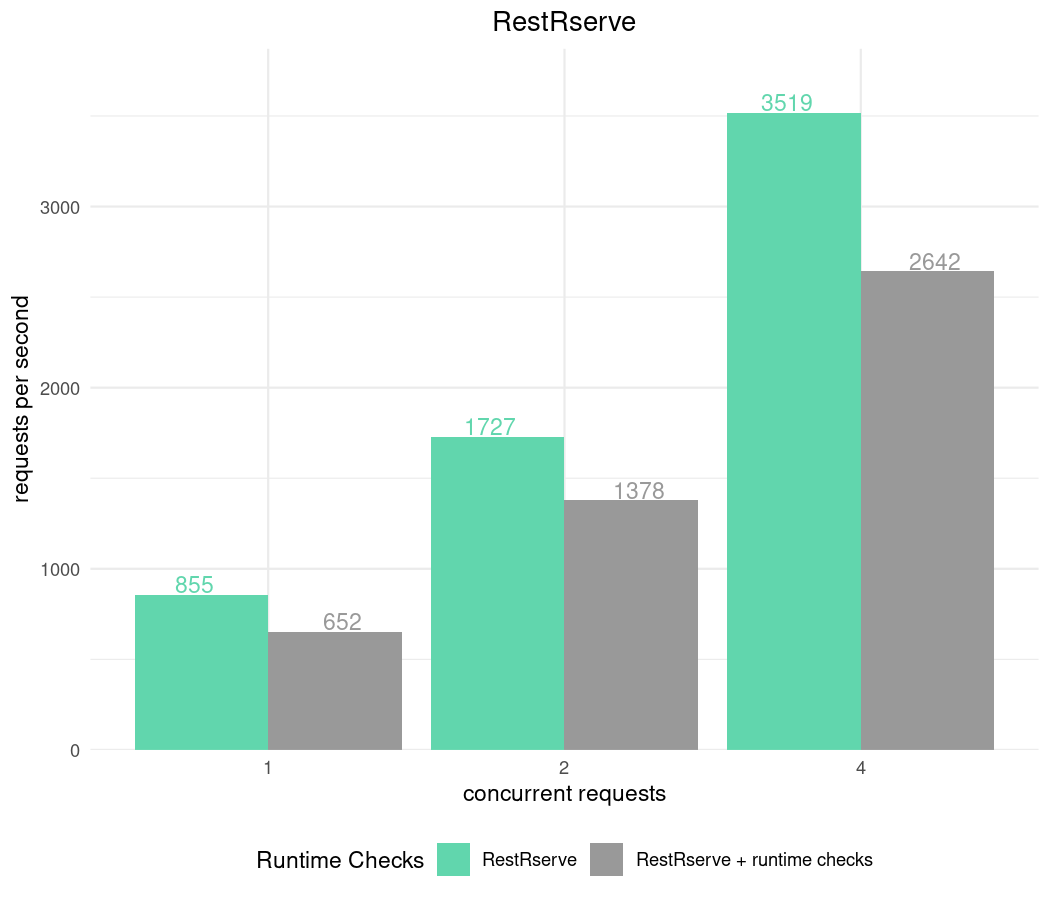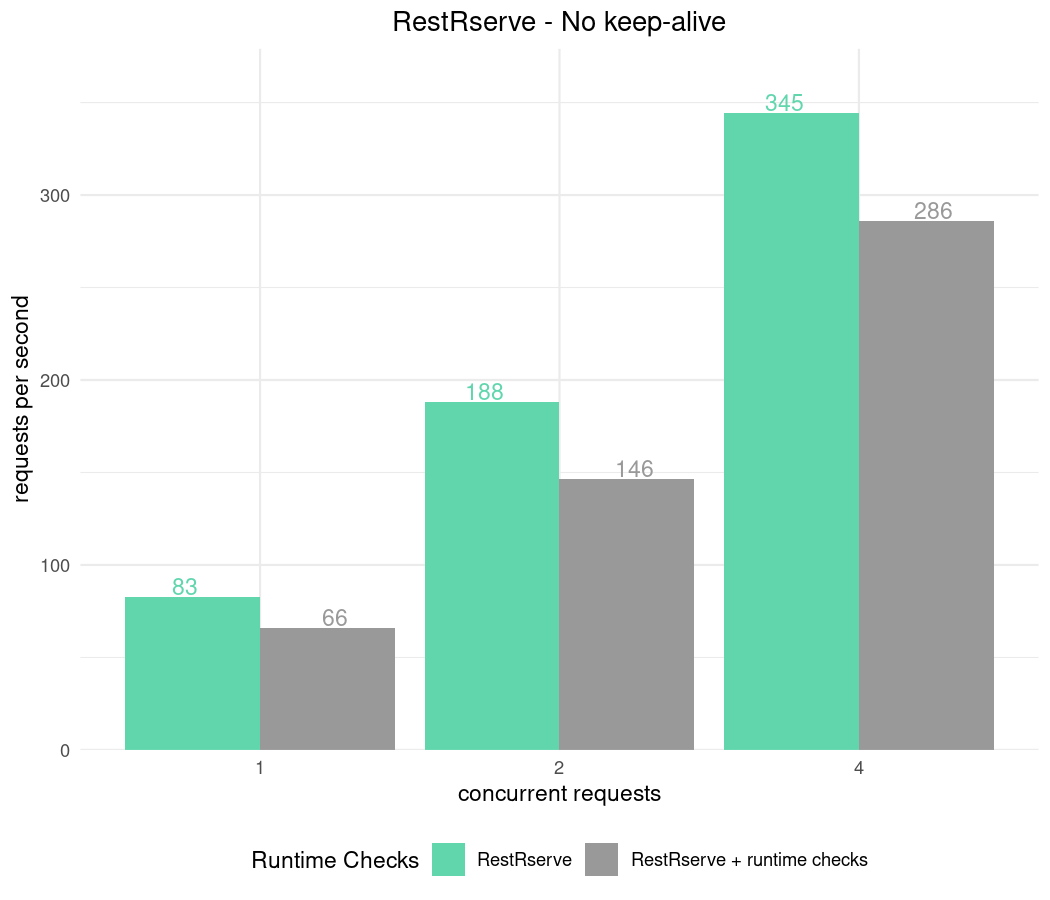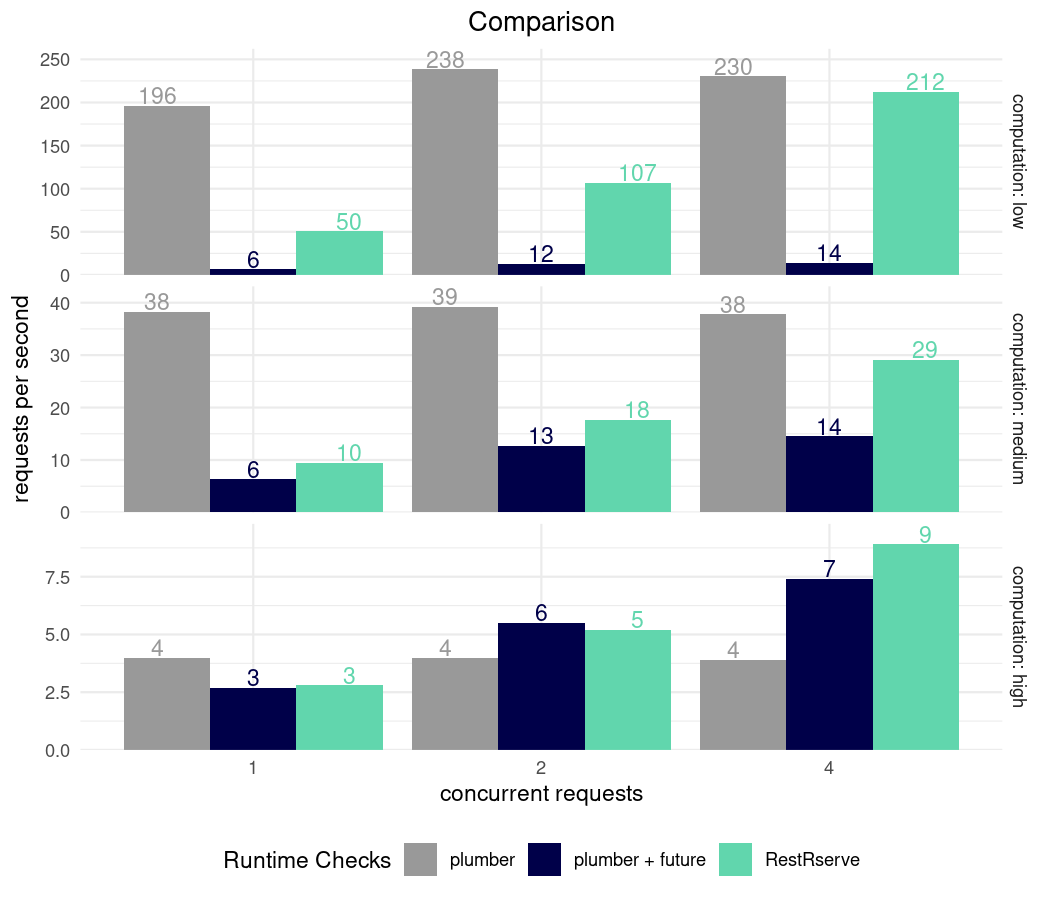Benchmarks
In RestRserve: A Framework for Building HTTP API
knitr::opts_chunk$set(
collapse = TRUE,
comment = "#>",
results = "markup",
# to regenerate the images and clear the output, set eval = TRUE
eval = FALSE
)
*All benchmarks below are done on a pretty old Intel Xeon X3470 CPU with 4 cores, 8 threads @ 2.93GHz . You can expect ~2x better performance on modern CPUs.
There are many tools to benchmark HTTP API. We will use apib which is successor of a standard ab tool.
We will benchmark a very simple web service - it receives HTTP request at /fib?n=10 and answers with fibonacci number.
Details and methodology
Our testing RestRserve application is implemented below:
calc_fib = function(n) {
if (n < 0L) stop("n should be >= 0")
if (n == 0L) return(0L)
if (n == 1L || n == 2L) return(1L)
x = rep(1L, n)
for (i in 3L:n) x[[i]] = x[[i - 1]] + x[[i - 2]]
x[[n]]
}
bench_app = function(calc_fn) {
library(RestRserve)
backend = BackendRserve$new()
app = Application$new(content_type = "text/plain")
app$logger$set_log_level("off")
app$add_get("/fib", FUN = function(request, response) {
n = as.integer(request$get_param_query("n"))
if (length(n) == 0L || is.na(n)) {
raise(HTTPError$bad_request())
}
response$set_body(list(answer = calc_fn(n)))
})
backend$start(app = app, http_port = 8080)
}
Sample calc_fib() benchmarking:
microbenchmark::microbenchmark(low = calc_fib(10), times = 10)
Benchmarking Rserve backend
At the moment RestRserve supports single backend - Rserve.
Configurations:
RestRserve can utilize all CPU cores and process requests in parallel. We will use multiple number of threads to see how it affects performance.- During application
RestRserve checks RESTRSERVE_RUNTIME_ASSERTS environment variable. It controls the amount of input validation RestRserve performs internally using checkmate package. Despite the fact that runtime checks comes with additional time overhead this variable is set to TRUE by default. We value correctness and robustness of the application at the first place. We will benchmark application with different values of RESTRSERVE_RUNTIME_ASSERTS to see the difference.
Code below implements allows to test combinations options:
library(callr)
library(data.table)
parse_apib_results = function(x) {
apib_executable_path = "apib"
#apib_executable_path = path.expand("~/projects/apib/release/apib/apib")
csv_header = system2(command = apib_executable_path,
args = "--header-line", stdout = T)
csv_header = strsplit(csv_header, ",", T)[[1]]
csv_header = c("n_threads", "fibonacci", "flavor", csv_header[-1])
if (length(x) == 1) x = paste0(x, "\n")
results = paste(x, collapse = "\n")
fread(results, col.names = csv_header)
}
run_apib = function(
n_threads = c(4, 2, 1),
n_sec = 5,
keep_alive = -1,
flavor = "",
fib_count = 10) {
apib_executable_path = "apib"
#apib_executable_path = path.expand("~/projects/apib/release/apib/apib")
results = character()
for (n_thread in n_threads) {
res = system2(
command = apib_executable_path,
args = sprintf(
"-c %d -d %d -k %d --csv-output \'http://127.0.0.1:8080/fib?n=%d\'",
n_thread, n_sec, keep_alive, fib_count
),
stdout = TRUE
)
results[[length(results) + 1]] = paste0(n_thread, ",", fib_count, ",", flavor, res)
}
results
}
apib_bench = function(
n_sec = 5,
keep_alive = -1,
fib_counts = 10,
runtime_checks = c(FALSE, TRUE)) {
results = character()
for (fib_count in fib_counts) {
for (runtime_check in runtime_checks) {
rr = r_bg(
bench_app,
list(calc_fn = calc_fib),
env = c("RESTRSERVE_RUNTIME_ASSERTS" = as.character(runtime_check))
)
# Wait for R to start
Sys.sleep(2)
flavor = if (runtime_check) "RestRserve + runtime checks" else "RestRserve"
results = c(
results,
run_apib(
n_sec = n_sec,
keep_alive = keep_alive,
flavor = flavor,
fib_count = fib_count
)
)
cat(sep = "",
"fibonacci: ", fib_count, "; flavor: ", flavor, "\n",
paste0(rr$read_output(), collapse = "\n"), "\n"
)
rr$kill_tree()
}
}
parse_apib_results(results)
}
library(ggplot2)
plot_results = function(x, title, file = NULL, facet = FALSE) {
colour_pal = c(
"RestRserve" = "#61D6AD",
"RestRserve + runtime checks" = "#999999",
"plumber" = "#999999",
"plumber + future" = "#000049"
)
p =
ggplot(x) +
geom_bar(aes(x = as.factor(n_threads), y = Throughput, fill = flavor),
stat = "identity", position = "dodge") +
geom_text(
aes(x = as.factor(n_threads), y = Throughput, col = flavor, label = round(Throughput)),
position = position_dodge(width = 1),
show.legend = FALSE,
vjust = -0.1
) +
scale_y_continuous(expand = expansion(mult = c(0., 0.1))) +
scale_fill_manual(values = colour_pal) +
scale_color_manual(values = colour_pal) +
theme_minimal() +
theme(
plot.title = element_text(hjust = 0.5),
legend.position = "bottom"
) +
labs(
x = "concurrent requests",
y = "requests per second",
title = title,
fill = "Runtime Checks",
col = NULL
)
if (facet) {
p = p +
facet_grid(fibonacci ~ ., scales = "free_y", labeller = function(labels) {
list(
fibonacci =
c("15" = "computation: low", "20" = "computation: medium", "25" = "computation: high")[
label_value(labels)$fibonacci
]
)
})
}
if (!is.null(file)) {
ggsave(file, p, height = 6, width = 7, dpi = 150)
}
p
}
results_runtime = apib_bench(keep_alive = -1, fib_counts = 10)
plot_results(
results_runtime,
"RestRserve",
"../img/bench-rps.png"
)

No keep-alive
Keep in mind that creating new connections is quite expensive for any HTTP server. For RestRserve's Rserve backend this is particularly true since for each new connection it forks a child process (which has relatively high cost). With other backends slow down might be less significant.
results_no_keep_alive = apib_bench(keep_alive = 0, fib_counts = 10)
plot_results(
results_no_keep_alive,
"RestRserve - No keep-alive",
"../img/bench-rps-no-keep-alive.png"
)

Nonetheless one can always put application behind proxy (such as HAproxy or nginx). It will
maintain pool of connections to RestRserve and hence won't suffer from creating new connections.
Comparison with Plumber
Support for promises and future was added in plumber v1.0.0. Extra coding will need to be done within a plumber definition to distinguish which routes utilize promises.
We will rewrite our calc_fib function in a less efficient way in order to simulate different amount of computation required by handler. We will benchmark frameworks against three styles of routes (low computation, n = 15; medium computation, n = 20; high computation, n = 25) using multiple apib testing threads (1, 2, 4).
calc_fib = function(n) {
calc_fib_rec = function(n) {
if (n < 0L) stop("n should be >= 0")
if (n == 0L) return(0L)
if (n == 1L || n == 2L) return(1L)
x = rep(1L, n)
for (i in 3L:n) x[[i]] = x[[i - 1]] + x[[i - 2]]
x[[n]]
calc_fib_rec(n - 1) + calc_fib_rec(n - 2)
}
calc_fib_rec(n)
}
microbenchmark::microbenchmark(
low = calc_fib(15),
medium = calc_fib(20),
high = calc_fib(25), times = 10
)
plumber_app = function(calc_fn, use_future = FALSE) {
if (isTRUE(use_future)) {
# multiple cores
library(future)
plan(multiprocess(workers = 4)) # max number of threads
fib_route = function(n = -1) {
n = as.integer(n)
if (is.na(n)) stop("\"n\"must be integer number.")
future({
calc_fn(n)
})
}
} else {
# single core
fib_route = function(n = -1) {
n = as.integer(n)
if (is.na(n)) stop("\"n\"must be integer number.")
calc_fn(n)
}
}
library(plumber)
pr() %>%
pr_get(
"/fib",
fib_route,
serializer = plumber::serializer_text()
) %>%
pr_run(port = 8080)
}
apib_bench_plumber = function(
n_sec = 5,
keep_alive = -1,
fib_counts = c(15, 20, 25)) {
results = character()
for (fib_count in fib_counts) {
for (use_future in list(TRUE, FALSE)) {
rr = r_bg(
plumber_app,
list(calc_fn = calc_fib, use_future = use_future),
stdout = "|", stderr = "2>&1"
)
Sys.sleep(2)
flavor = if (use_future) "plumber + future" else "plumber"
results = c(
results,
run_apib(
n_threads = c(4, 2, 1),
n_sec = n_sec,
keep_alive = keep_alive,
flavor = flavor,
fib_count = fib_count
)
)
cat(sep = "",
"fibonacci: ", fib_count, "; flavor: ", flavor, "\n",
paste0(rr$read_output(), collapse = "\n"), "\n"
)
rr$kill_tree()
}
}
parse_apib_results(results)
}
N_SEC = 10
results_restrserve = apib_bench(fib_counts = c(15, 20, 25), keep_alive = -1,
runtime_checks = FALSE, n_sec = N_SEC)
results_plumber = apib_bench_plumber(fib_counts = c(15, 20, 25), keep_alive = -1, n_sec = N_SEC)
results_compare = rbindlist(list(results_plumber, results_restrserve))
Results
plot_results(
results_compare,
"Comparison",
"../img/bench-rps-vs-plumber.png",
facet = TRUE
)

As can be seen RestRserce performs very well on every workload and scales linearly with number of cores.
keep-alive disabled
Additionally we may explore environments where web-service exposed directly to many clients without having load balancer or proxy behind it. This is not very common across real-world deployments, but still worth to keep in mind. We can be simulate such scenario by setting keep_alive = 0:
results_restrserve = apib_bench(fib_counts = c(15, 20, 25), keep_alive = 0,
runtime_checks = FALSE, n_sec = N_SEC)
results_plumber = apib_bench_plumber(fib_counts = c(15, 20, 25), keep_alive = 0, n_sec = N_SEC)
results_compare = rbindlist(list(results_plumber, results_restrserve))
plot_results(
results_compare,
"Comparison",
"../img/bench-rps-vs-plumber-no-keepalive.png",
facet = TRUE
)

Due to the overhead of creating a new process for each request and R's byte compiler overhead RestRserve with Rserve backend does not perform as quickly as plumber when computing instantaneous routes. However, RestRserve still shows it's strength when executing routes that have high computational costs. No extra coding logic is needed to leverage RestRserve's multi-threaded execution. Mixing plumber and future together for high computation routes brings performance that scales with the number of concurrent requests, but at the cost of extra route logic and domain knowledge.
Try the RestRserve package in your browser
Any scripts or data that you put into this service are public.
RestRserve documentation built on April 4, 2025, 2:18 a.m.
knitr::opts_chunk$set( collapse = TRUE, comment = "#>", results = "markup", # to regenerate the images and clear the output, set eval = TRUE eval = FALSE )
*All benchmarks below are done on a pretty old Intel Xeon X3470 CPU with 4 cores, 8 threads @ 2.93GHz . You can expect ~2x better performance on modern CPUs.
There are many tools to benchmark HTTP API. We will use apib which is successor of a standard ab tool.
We will benchmark a very simple web service - it receives HTTP request at /fib?n=10 and answers with fibonacci number.
Details and methodology
Our testing RestRserve application is implemented below:
calc_fib = function(n) { if (n < 0L) stop("n should be >= 0") if (n == 0L) return(0L) if (n == 1L || n == 2L) return(1L) x = rep(1L, n) for (i in 3L:n) x[[i]] = x[[i - 1]] + x[[i - 2]] x[[n]] } bench_app = function(calc_fn) { library(RestRserve) backend = BackendRserve$new() app = Application$new(content_type = "text/plain") app$logger$set_log_level("off") app$add_get("/fib", FUN = function(request, response) { n = as.integer(request$get_param_query("n")) if (length(n) == 0L || is.na(n)) { raise(HTTPError$bad_request()) } response$set_body(list(answer = calc_fn(n))) }) backend$start(app = app, http_port = 8080) }
Sample calc_fib() benchmarking:
microbenchmark::microbenchmark(low = calc_fib(10), times = 10)
Benchmarking Rserve backend
At the moment RestRserve supports single backend - Rserve.
Configurations:
RestRservecan utilize all CPU cores and process requests in parallel. We will use multiple number of threads to see how it affects performance.- During application
RestRservechecksRESTRSERVE_RUNTIME_ASSERTSenvironment variable. It controls the amount of input validationRestRserveperforms internally using checkmate package. Despite the fact that runtime checks comes with additional time overhead this variable is set toTRUEby default. We value correctness and robustness of the application at the first place. We will benchmark application with different values ofRESTRSERVE_RUNTIME_ASSERTSto see the difference.
Code below implements allows to test combinations options:
library(callr) library(data.table) parse_apib_results = function(x) { apib_executable_path = "apib" #apib_executable_path = path.expand("~/projects/apib/release/apib/apib") csv_header = system2(command = apib_executable_path, args = "--header-line", stdout = T) csv_header = strsplit(csv_header, ",", T)[[1]] csv_header = c("n_threads", "fibonacci", "flavor", csv_header[-1]) if (length(x) == 1) x = paste0(x, "\n") results = paste(x, collapse = "\n") fread(results, col.names = csv_header) } run_apib = function( n_threads = c(4, 2, 1), n_sec = 5, keep_alive = -1, flavor = "", fib_count = 10) { apib_executable_path = "apib" #apib_executable_path = path.expand("~/projects/apib/release/apib/apib") results = character() for (n_thread in n_threads) { res = system2( command = apib_executable_path, args = sprintf( "-c %d -d %d -k %d --csv-output \'http://127.0.0.1:8080/fib?n=%d\'", n_thread, n_sec, keep_alive, fib_count ), stdout = TRUE ) results[[length(results) + 1]] = paste0(n_thread, ",", fib_count, ",", flavor, res) } results } apib_bench = function( n_sec = 5, keep_alive = -1, fib_counts = 10, runtime_checks = c(FALSE, TRUE)) { results = character() for (fib_count in fib_counts) { for (runtime_check in runtime_checks) { rr = r_bg( bench_app, list(calc_fn = calc_fib), env = c("RESTRSERVE_RUNTIME_ASSERTS" = as.character(runtime_check)) ) # Wait for R to start Sys.sleep(2) flavor = if (runtime_check) "RestRserve + runtime checks" else "RestRserve" results = c( results, run_apib( n_sec = n_sec, keep_alive = keep_alive, flavor = flavor, fib_count = fib_count ) ) cat(sep = "", "fibonacci: ", fib_count, "; flavor: ", flavor, "\n", paste0(rr$read_output(), collapse = "\n"), "\n" ) rr$kill_tree() } } parse_apib_results(results) }
library(ggplot2) plot_results = function(x, title, file = NULL, facet = FALSE) { colour_pal = c( "RestRserve" = "#61D6AD", "RestRserve + runtime checks" = "#999999", "plumber" = "#999999", "plumber + future" = "#000049" ) p = ggplot(x) + geom_bar(aes(x = as.factor(n_threads), y = Throughput, fill = flavor), stat = "identity", position = "dodge") + geom_text( aes(x = as.factor(n_threads), y = Throughput, col = flavor, label = round(Throughput)), position = position_dodge(width = 1), show.legend = FALSE, vjust = -0.1 ) + scale_y_continuous(expand = expansion(mult = c(0., 0.1))) + scale_fill_manual(values = colour_pal) + scale_color_manual(values = colour_pal) + theme_minimal() + theme( plot.title = element_text(hjust = 0.5), legend.position = "bottom" ) + labs( x = "concurrent requests", y = "requests per second", title = title, fill = "Runtime Checks", col = NULL ) if (facet) { p = p + facet_grid(fibonacci ~ ., scales = "free_y", labeller = function(labels) { list( fibonacci = c("15" = "computation: low", "20" = "computation: medium", "25" = "computation: high")[ label_value(labels)$fibonacci ] ) }) } if (!is.null(file)) { ggsave(file, p, height = 6, width = 7, dpi = 150) } p }
results_runtime = apib_bench(keep_alive = -1, fib_counts = 10)
plot_results( results_runtime, "RestRserve", "../img/bench-rps.png" )

No keep-alive
Keep in mind that creating new connections is quite expensive for any HTTP server. For RestRserve's Rserve backend this is particularly true since for each new connection it forks a child process (which has relatively high cost). With other backends slow down might be less significant.
results_no_keep_alive = apib_bench(keep_alive = 0, fib_counts = 10)
plot_results( results_no_keep_alive, "RestRserve - No keep-alive", "../img/bench-rps-no-keep-alive.png" )

Nonetheless one can always put application behind proxy (such as HAproxy or nginx). It will maintain pool of connections to RestRserve and hence won't suffer from creating new connections.
Comparison with Plumber
Support for promises and future was added in plumber v1.0.0. Extra coding will need to be done within a plumber definition to distinguish which routes utilize promises.
We will rewrite our calc_fib function in a less efficient way in order to simulate different amount of computation required by handler. We will benchmark frameworks against three styles of routes (low computation, n = 15; medium computation, n = 20; high computation, n = 25) using multiple apib testing threads (1, 2, 4).
calc_fib = function(n) { calc_fib_rec = function(n) { if (n < 0L) stop("n should be >= 0") if (n == 0L) return(0L) if (n == 1L || n == 2L) return(1L) x = rep(1L, n) for (i in 3L:n) x[[i]] = x[[i - 1]] + x[[i - 2]] x[[n]] calc_fib_rec(n - 1) + calc_fib_rec(n - 2) } calc_fib_rec(n) }
microbenchmark::microbenchmark( low = calc_fib(15), medium = calc_fib(20), high = calc_fib(25), times = 10 )
plumber_app = function(calc_fn, use_future = FALSE) { if (isTRUE(use_future)) { # multiple cores library(future) plan(multiprocess(workers = 4)) # max number of threads fib_route = function(n = -1) { n = as.integer(n) if (is.na(n)) stop("\"n\"must be integer number.") future({ calc_fn(n) }) } } else { # single core fib_route = function(n = -1) { n = as.integer(n) if (is.na(n)) stop("\"n\"must be integer number.") calc_fn(n) } } library(plumber) pr() %>% pr_get( "/fib", fib_route, serializer = plumber::serializer_text() ) %>% pr_run(port = 8080) } apib_bench_plumber = function( n_sec = 5, keep_alive = -1, fib_counts = c(15, 20, 25)) { results = character() for (fib_count in fib_counts) { for (use_future in list(TRUE, FALSE)) { rr = r_bg( plumber_app, list(calc_fn = calc_fib, use_future = use_future), stdout = "|", stderr = "2>&1" ) Sys.sleep(2) flavor = if (use_future) "plumber + future" else "plumber" results = c( results, run_apib( n_threads = c(4, 2, 1), n_sec = n_sec, keep_alive = keep_alive, flavor = flavor, fib_count = fib_count ) ) cat(sep = "", "fibonacci: ", fib_count, "; flavor: ", flavor, "\n", paste0(rr$read_output(), collapse = "\n"), "\n" ) rr$kill_tree() } } parse_apib_results(results) }
N_SEC = 10 results_restrserve = apib_bench(fib_counts = c(15, 20, 25), keep_alive = -1, runtime_checks = FALSE, n_sec = N_SEC) results_plumber = apib_bench_plumber(fib_counts = c(15, 20, 25), keep_alive = -1, n_sec = N_SEC) results_compare = rbindlist(list(results_plumber, results_restrserve))
Results
plot_results( results_compare, "Comparison", "../img/bench-rps-vs-plumber.png", facet = TRUE )

As can be seen RestRserce performs very well on every workload and scales linearly with number of cores.
keep-alive disabled
Additionally we may explore environments where web-service exposed directly to many clients without having load balancer or proxy behind it. This is not very common across real-world deployments, but still worth to keep in mind. We can be simulate such scenario by setting keep_alive = 0:
results_restrserve = apib_bench(fib_counts = c(15, 20, 25), keep_alive = 0, runtime_checks = FALSE, n_sec = N_SEC) results_plumber = apib_bench_plumber(fib_counts = c(15, 20, 25), keep_alive = 0, n_sec = N_SEC) results_compare = rbindlist(list(results_plumber, results_restrserve))
plot_results( results_compare, "Comparison", "../img/bench-rps-vs-plumber-no-keepalive.png", facet = TRUE )

Due to the overhead of creating a new process for each request and R's byte compiler overhead RestRserve with Rserve backend does not perform as quickly as plumber when computing instantaneous routes. However, RestRserve still shows it's strength when executing routes that have high computational costs. No extra coding logic is needed to leverage RestRserve's multi-threaded execution. Mixing plumber and future together for high computation routes brings performance that scales with the number of concurrent requests, but at the cost of extra route logic and domain knowledge.
Try the RestRserve package in your browser
Any scripts or data that you put into this service are public.
Add the following code to your website.
For more information on customizing the embed code, read Embedding Snippets.
